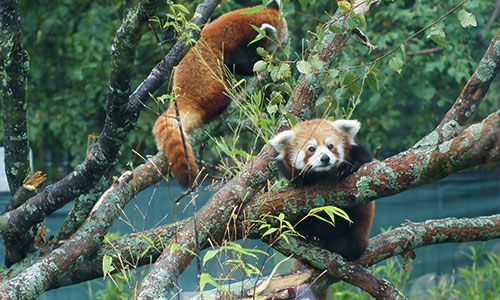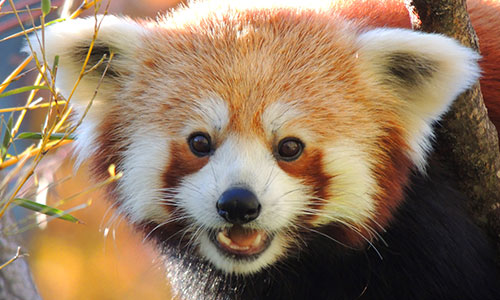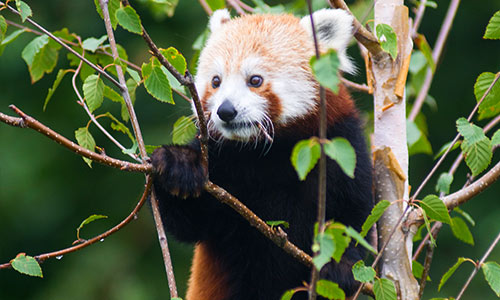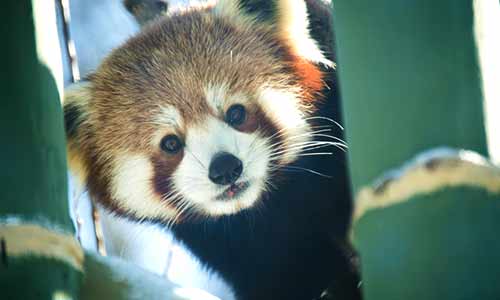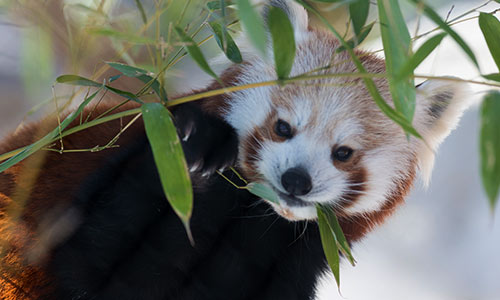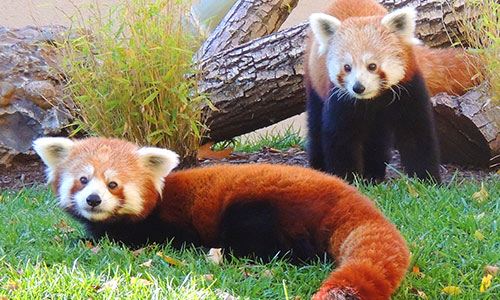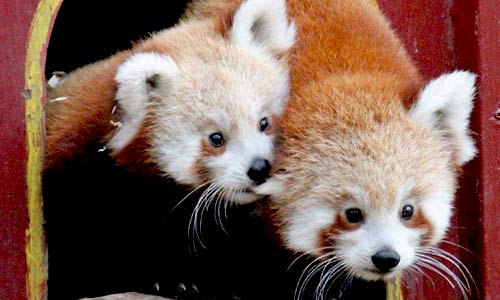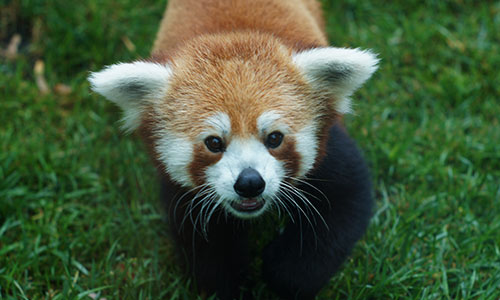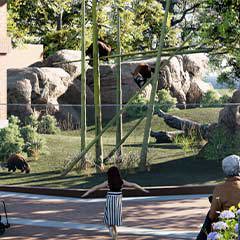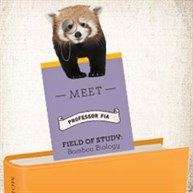Red Panda
Ailurus fulgens
About the Red Panda

Geographic Range:
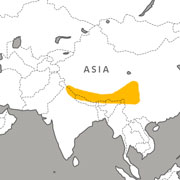
Class: Mammalia
Order: Carnivora
Family: Ailuridae
Genus: Ailurus
Species: fulgens
Two subspecies at Franklin Park Zoo:
- Ailurus fulgens fulgens
- Ailurus fulgens refulgens (styani)
The red panda resembles a raccoon because of its ringed tail and mask-like face. It's named for the soft, dense red fur that covers even the soles of its feet, keeping it warm in the forests of its Himalayan habitat. The red panda’s daily grooming ritual includes licking the soles of its furry feet. The red panda has a bushy tail that provides balance while climbing trees, where its red-and-white markings camouflage it among the mosses and lichens that grow on the trees of its habitat.
Committed to Conservation
Zoo New England participates in the red panda Species Survival Plan. By sharing research and knowledge, participating institutions work together to establish guidelines that best ensure the health of captive populations, and with success, the survival of endangered species.
Red Panda Facts
Comparing the subspecies:
Ailurus fulgens fulgens
- Found in Nepal, northeastern India (West Bengal, Sikkim, Arunachal Pradesh), Bhutan, and part of China
- Tend to be the smaller of the two species with lighter fur around the face
Ailurus fulgens refulgens
- Only found in China (in the Hengduan Mountains in Sichuan and the East Nujiang River of Yunnan Province) and northern Myanmar
- Tend to be heavier and darker than the fulgens subspecies
Appearance:
The red panda is a raccoon-like mammal that is furry and red with soft, dense fur. This coat covers its entire body, even the soles of its feet, to keep the panda warm and reduce heat loss in the cold. They use their long, bushy tails to cover their face and keep their nose warm in the cold, as well as for balance when climbing in the trees.
Red pandas have red and white markings on their faces and ringed tails that help them blend in with mosses and lichens growing on trees in their habitat. Their ears are large and pointed with white edges. Their feet are fully furred, and semi-retractable razor-sharp claws help pandas climb trees. Like the giant panda, red pandas have a bony projection on their wrist that acts like a thumb. This helps them grip bamboo stalks. Their large mouths and powerful jaws and teeth help them crush the stalks.
Red pandas are an ancient species in the order Carnivora (superfamily Musteloidea) and are probably most closely related to the group that includes weasels, raccoons and skunks.
Size:
Weight: 6.5 to 14 pounds
Length: The head and body length of an adult red panda ranges from 20–26 inches and the tail is another 12–20 inches long
Diet:
Though they're classified as carnivores, red pandas primarily eat a vegetarian diet of bamboo leaves, berries, roots, blossoms and the leaves of various plants. They will sometimes also eat birds’ eggs, insects, small rodents and young birds.
Reproduction:
In the northern hemisphere, red pandas breed in January–February and give birth in June–July. After a gestation period of 134 days (though it can range from 93–156 days), females give birth to one to four cubs (two on average). Cubs are born with all their fur but are blind and helpless. Their eyes typically open after two to four weeks. Cubs remain in the nest for 90 days and are weaned around five months. They stay with their mother for up to one year, and reach sexual maturity in approximately one year, seven months (the second breeding season after birth).
Behavior:
Red pandas are typically shy and solitary except during mating season. They're mostly active at dawn and dusk (crepuscular), sleeping in trees during the day. They communicate through a variety of noises including shrill cries, whistling and chirping. Pandas groom themselves daily. There is a difference in the way they scent mark; females mark in a figure 8 while males mark side to side.
Habitat/Range:
Red pandas are native to Bhutan, China, India, Myanmar and Nepal. They live in temperate mountain forests of the Himalayas, usually at elevations between 2,200 and 4,800 meters, where there is thick bamboo understory.
Median Life Expectancy:
8 years
Threats in the Wild:
Major threats include habitat loss and fragmentation, habitat degradation by logging, physical threats (capture for the pet trade and/or unintentionally caught in other wildlife traps) and poaching for trade (skins and body parts). Increased human populations and the movement of cattle herds are also disrupting red panda habitat and safety. Because red pandas have a slow rate of reproduction due to slow growth, it is difficult for red pandas to recover from population declines.
Fun Facts:
- The red panda is also called firefox, bear-cat, lesser panda, first panda and red cat-bear.
- The red panda has a modified wrist bone that acts as a sixth digit or thumb.
- Red pandas are in the order Carnivora and are the only species in the family Ailuridae. Even though they are classified as carnivores, it's estimated that the wild diet is more than 95% bamboo.
- Prehistoric red panda fossils have been found in the Smoky Mountains in Tennessee.
- Females scent mark in a figure 8 pattern while males mark side to side.
You Can Find This Animal in the Children's Zoo
Red Panda Conservation Complex
Help expand our red panda habitat with a donation to the Red Panda Conservation Complex
Zoodopt a Red Panda
Zoodopts support the care and feeding of our animals, and with each purchase, we'll bring a little of the Zoo to you! More
Go Behind the Scenes!
You don't have to travel to a bamboo forest to meet red pandas! Visit them right here in our Children's Zoo and learn more from zookeepers and educators.
You might also like
At Franklin Park Zoo:
At Stone Zoo:

